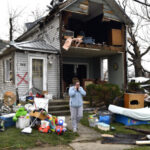Washington’s Department of Natural Resources is following through with a key safety recommendation that arose in the aftermath of the Oso mudslide, as it starts to post intricate topographical maps online.
The state generates the maps through laser-imaging technology known as lidar. By showing accurate contours of the land, the aerial images help point out areas at risk for landslides, flooding, tsunamis and other natural disasters.
The maps went online last week as a beta, or test, version. DNR expects to post more on its lidar portal in the coming weeks.
“We are focusing that on populated areas and areas where there is infrastructure,” said Dave Norman, the state geologist.
The mudslide that struck near Oso in March 2014 killed 43 people in and around the Steelhead Haven neighborhood. Later that year, state and Snohomish County officials convened an expert commission to examine lessons in areas such as land-use planning and emergency response.
Among other findings, commissioners concluded that Washington lacked adequate maps to show landslide risks and other geologic hazards. The next state budget committed $36 million through 2021 to enhance DNR’s abilities to understand geological hazards through the best technology available.
So far, the DNR officials have amassed high-quality lidar data for 17,049 square miles, Norman said. That’s nearly 24 percent of the state. The DNR is partway through posting that information online. DNR’s lidar portal draws from the department’s own inventory as well as from the Puget Sound Lidar Consortium, counties and cities.
More flights are due soon to run lidar over other parts of the state. That work is likely to include Puget Sound’s coastal bluffs, where sloughing has been a regular nuisance and danger for the BNSF Railway tracks, homes and roads. That information could go online by next fall or winter, Norman said.
Lidar stands for Light Detection and Ranging. It employs lasers mounted on aircraft to scope topography by measuring reflected light. The beams can make it through tree cover and some man-made features to show the landscape below.
“The most important thing about lidar is it really provides a very accurate elevation model and image of the earth that you can’t get (otherwise) because it’s obscured by vegetation or other things,” Norman said.
The information is helpful to developers, land-use planners, emergency management officials, engineers and scientists. It provides a clearer picture of flood plains, seismic fault lines and volcanic hazard areas. Lidar images help scientists model how water might behave during tsunamis or floods.
The technology also is useful in forestry, to estimate tree growth and identify wildlife habitat. Lidar also can reveal archaeological sites hidden by tree cover.
Snohomish County planners already use lidar data from other sources to inform land-use decisions. They “will definitely use this as one more tool in the box for evaluating landslide hazard areas in the future,” said Tom Rowe, a long-time planning department manager who now works in the county executive’s office. “We have explored all of the data that’s out there. We are using all of the sites that we’re aware of.”
Similarly, the county’s emergency managers also have been putting lidar data to use and see the state data as a welcome addition.
“We’re definitely aware of it and will make use of it as able,” said Heather Kelly, a spokeswoman for the county’s Department of Emergency Management. “We use any resource we can during our planing and our incident response.”
To view the state data, go to lidarportal.dnr.wa.gov and www.dnr.wa.gov/lidar.
Was this article valuable?
Here are more articles you may enjoy.

 Harvard Study Again Stirs the Pot on Demotech Ratings of Florida Carriers
Harvard Study Again Stirs the Pot on Demotech Ratings of Florida Carriers  California Sees Two More Property Insurers Withdraw From Market
California Sees Two More Property Insurers Withdraw From Market  Gallagher: Global Insured Natural Disaster Claims Again Dominated by Severe U.S. Storms
Gallagher: Global Insured Natural Disaster Claims Again Dominated by Severe U.S. Storms  Hawaiian Electric Hits 40-Year Low Ahead of Maui Fire Report
Hawaiian Electric Hits 40-Year Low Ahead of Maui Fire Report 